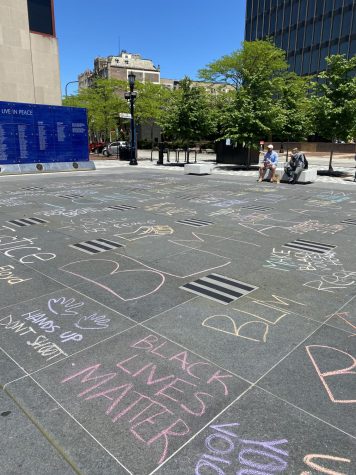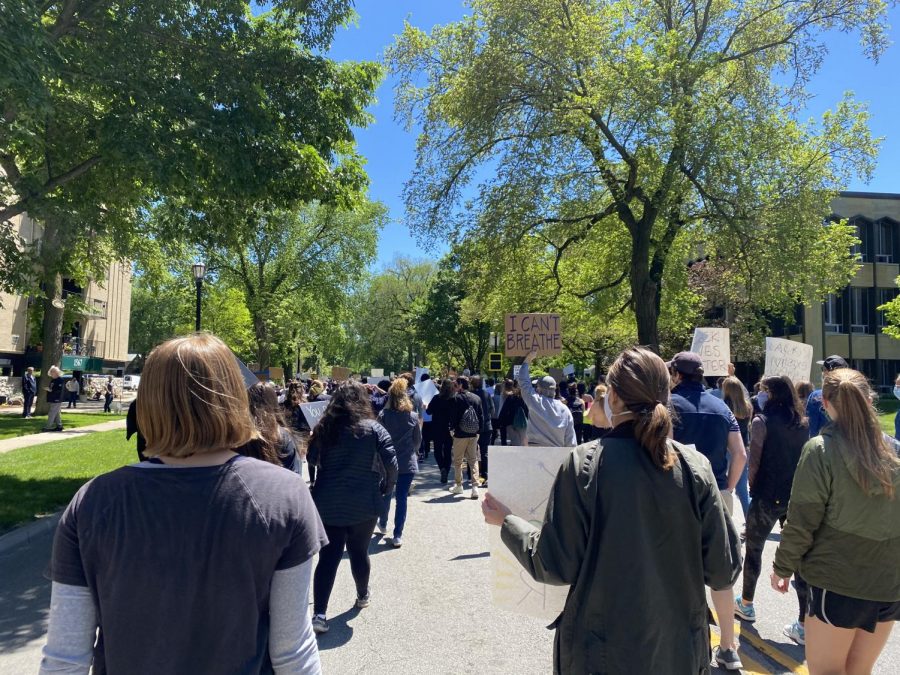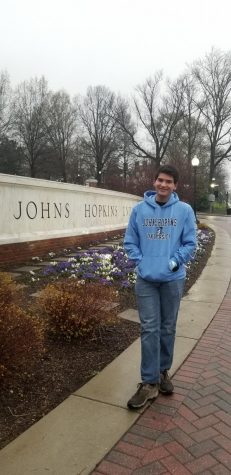Evanstonians unite to demand action
June 7, 2020
In the days following the traumatic death of George Floyd, people the nation over have erupted in protest against violent acts of brutality—such as those against Ahmaud Arbery and Breonna Taylor—and anti-Blackness that dominates American life.
One such demonstration, organized by recent ETHS graduates and other community organizers, took place on May 31, with more than 5,000 people joining together in the 1.5 mile march from the intersection of Church and Ridge to ETHS to demand action and change from the officials involved in the deaths of Floyd, Arbery and Taylor.
The protest consisted of the march and an hour of speeches, during which participants were given time to call officials and demand justice for Floyd and Taylor, followed by an open mic. In total, 26 speakers addressed the crowd and shared their stories about facing anti-Blackness both in Evanston and elsewhere.
While the march was announced with the aim of honoring Arbery, Floyd and Taylor, equally important were denouncements of the Evanston Police Department’s (EPD) May 27 arrest and use-of-force against Kevin Washington and Trent Hunt, both 20, and the Skokie Police Department’s March 30 shooting of Demetrius Bogan, 24, highlighted as anti-Black violence within the Evanston community, with Hunt speaking to the audience.
Bogan’s mother, Vernice Bogan, also spoke at the rally, expressing her outrage at the Skokie Police and demanding justice for her son.
“The Skokie police released the narrative that they were in fear of their lives. They saw my son as a threat, and so they shot him. Without a body cam video, we have to work our way through a system that isn’t blind,” Vernince Bogan said. “I’m here to say that we can’t just rally for lives lost. We need you all, and we need you all to educate the survivors.”
Bogan was joined in speaking out against Evanston’s treatment of its Black residents by, among others, senior and Student Representative Carmiya Bady, who spoke about the trauma inflicted by the EPD on her brother after being arrested for riding on the back pegs of a bike, something he was unaware of being a punishable offense.

“When my brother was 12 years old, he got arrested…. [EPD] said that he was riding on the back pegs of a bike. He didn’t know…. it was so disheartening to me because I couldn’t get an answer,” Bady said. “My brother never got closure. I never got closure. It is a problem, it is an issue and it is taking people’s lives. My brother is going to be traumatized for the rest of his life.”
While the EPD has been involved in a number of conversations with groups such as the Evanston NAACP, branch President Michael Nabors was far from the only participant to expose the racism faced by Evanston’s Black community and by the nation are deeply rooted in America’s history of exploitation of Black bodies.
“There is an inheritance and a structural system of racism and law enforcement in the United States, and here in Evanston. There is an ethos that is more entrenched than any principles could ever cover, and there are unwritten codes that influence attitudes; a negative code creates negative attitudes, and negative attitudes in a police officer create negative actions, and negative actions create results that are detrimental and often result in death,” Nabors said.
City Clerk Devon Reid spoke as well, urging participants to vote in the upcoming election to not only impact the national conversation but to change the local community through civic engagement and involvement.
“Folks can’t just show up to protests and rallies. They need to show up to vote, show up at committee meetings, make sure you’re informed and you know what’s going on in your community because we can change this locally,” Reid said. “I hope all of us use this as a renewed sense of engagement.”
Senior Meena Sharma, who attended the May 31 protest and is a member of the Students Organized Against Racism board, shares Reid’s optimism that while “it’s going to take years of people committing [to] and sustaining change, this is a place to start, become energized and realize that the work needs to start now and be carried out forever.”
Despite the large crowd, efforts were made to protect public health during the ongoing COVID-19 Pandemic with the majority of protesters wearing masks and standing in designated locations in the ETHS parking lot with an appropriate social distance between them.
Evanston has continued the work of demanding justice following the May 31 protest, with another march that took place on June 4 from Golf and McCormick to Dempster and McCormick, a series of stations and posters designed to spark conversations about White privilege displayed on Central Street on June 6 and a student-produced, fundraiser performance taking place on June 8 in Mason Park.
“The work does not end here; one protest is not enough. We must continue to fight every single day for every single Black life. Evanston has made strides to protect the Black community… but as we saw this past week we have a lot more to do,” May 31 protest organizer Maia Robinson said. “We must forever make protecting Black lives a priority.”
Executive Editor Nora Miller contributed to this piece.










